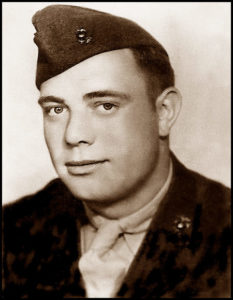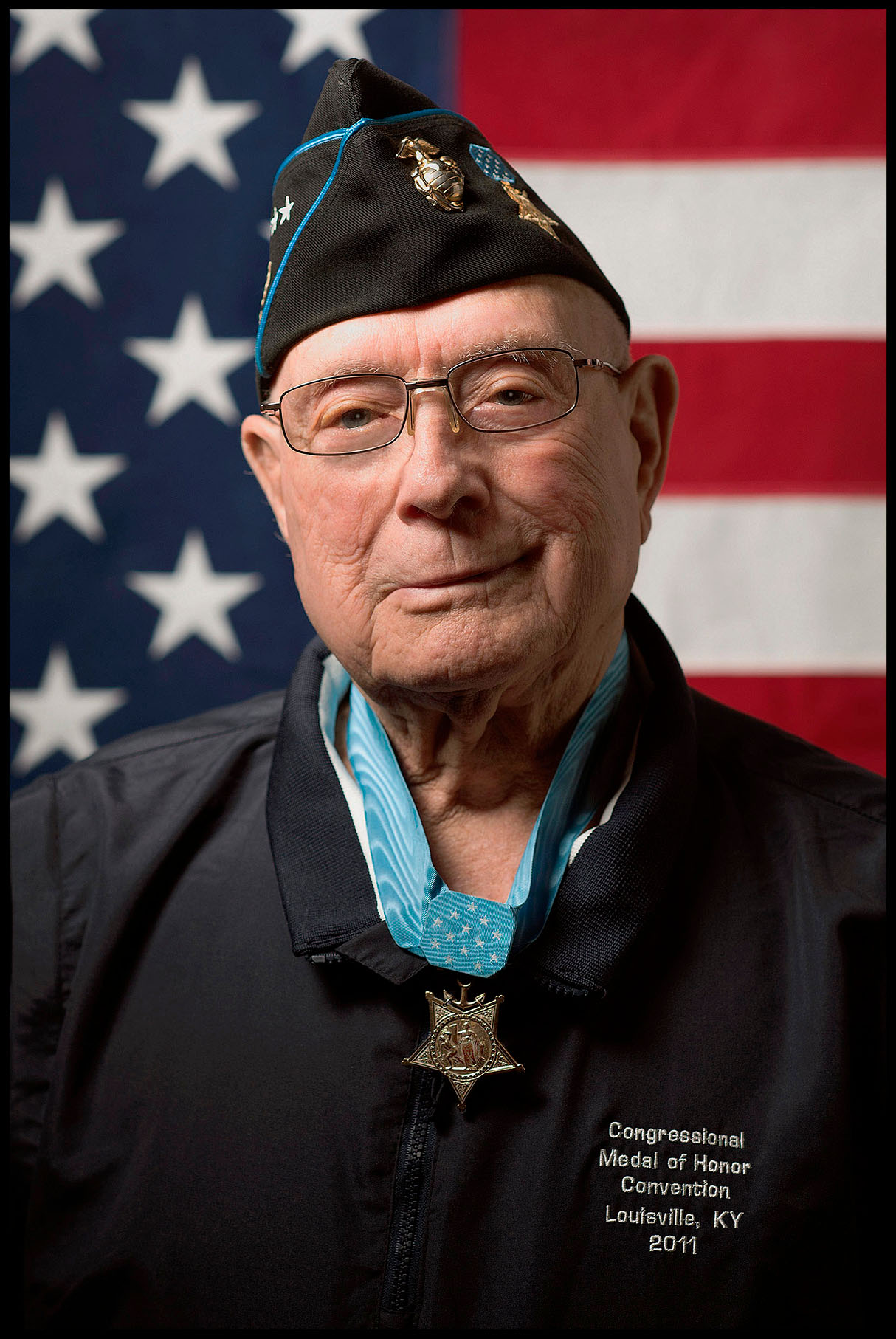Hershel W. Williams
Medal of Honor
Battle of Iwo Jima
Hershel W. Williams
Chief Warrant Officer 4, USMC, Ret.
1943–1945 & 1952–1969

Pfc. Hershel W. Williams
San Diego, CA, 1944
When my company was taken off the front line (on Iwo Jima) a week and a half later, all but 17 of the 279 men who had hit the beach with me had been killed or wounded… . I am the last living Medal of Honor awardee from World War II.
I was born in Fairmont, West Virginia on October 2, 1923, and grew up on a dairy farm in nearby Quiet Dell. As a kid I worked a series of odd jobs, always assuming that I was going to be a farmer. But when I saw some local Marines in their dress blues, I knew if I ever had to join the military, I would join the Marines. They were always tall, straight, and proud.
When Pearl Harbor was attacked, I was 17 and working in Montana as a Civilian Conservation Corps enrollee. Nobody in the group knew where Pearl Harbor was or what it was, just that it was associated with the United States somehow. We were given the choice of joining the Army or going home and joining another branch of the service. I came home to join the Marine Corps. They turned me down—I was too young.
I had a friend who worked for a cab company; he was the dispatcher. I began working from 6pm to 6am. At that time the notice of death was sent through Western Union from the War Department. The notices were sent by ticker tape and they glued the ticker tape to a telegram. The regular Western Union telegram was yellow. They put it in a War Department dirty brown envelope. They were sent around 2pm, and would be ready to deliver around 6pm-7pm. We knew it was a War Department telegram. As soon as people saw the color of the envelope, they knew what it was for. As an 18-year-old I didn’t know how to handle it. Again, I went down and tried to join the Marine Corps. They turned me down—I was too short. By the time I turned 19, the Marines had lowered their height restriction, and I joined.
I did my recruit training at the Marine Corps Recruit Depot in San Diego, California. Then I shipped out to the Pacific with the 3rd Marine Divisionand was assigned to a flamethrower/demolition unit. During July and August,1944 I participated in action against the Japanese at Guam, which seemed horrific until I landed on Iwo Jimathe following year. The beach area in Guam was relatively undefended, so we could advance into the jungle. At Iwo, all the jungle cover had been blown away, and the beach became a slaughterhouse.
I landed on Iwo on February 21, 1945. Two days later, the day that famous photograph of the flag raising was taken, our tanks were stuck in the volcanic sand as they tried to open a lane for the infantry through a network of reinforced concrete pillboxes. My captain asked me if I could do something. I strapped on a flamethrower and went after the pillboxes.
When my company was taken off the front line a week and a half later, all but 17 of the 279 men who had hit the beach with me had been killed or wounded. I was wounded on March 6th, and was awarded the Purple Heart.
In September, 1945 I returned to the United States. In 1954 I joined the Organized Marine Reserve and advanced through the warrant officer ranks until reaching my final rank of Chief Warrant Officer4 (CWO4). I was honorarily retired from the Marine Corps Reserve in 1969.
I struggled with the after-effects of combat stress until 1962, when I experienced a religious renewal. I later served as chaplain of the Congressional Medal of Honor Society for 35 years. My latest project has been an effort to build memorials honoring Gold Star Families in all 50 states. Gold Star Families are families that have lost a loved one in combat.
My lovely wife Ruby and I were married for 62 years. {03-31-2016 • Fort Worth, TX}
Medal of Honor Citation
For conspicuous gallantry and intrepidity at the risk of his life above and beyond the call of duty as demolition sergeant serving with the 21st Marines, 3d Marine Division, in action against enemy Japanese forces on Iwo Jima, Volcano Islands, 23 February 1945. Quick to volunteer his services when our tanks were maneuvering vainly to open a lane for the infantry through the network of reinforced concrete pillboxes, buried mines, and black volcanic sands, Cpl. Williams daringly went forward alone to attempt the reduction of devastating machinegun fire from the unyielding positions. Covered only by 4 riflemen, he fought desperately for 4 hours under terrific enemy small-arms fire and repeatedly returned to his own lines to prepare demolition charges and obtain serviced flamethrowers, struggling back, frequently to the rear of hostile emplacements, to wipe out 1 position after another. On 1 occasion, he daringly mounted a pillbox to insert the nozzle of his flamethrower through the air vent, killing the occupants and silencing the gun; on another he grimly charged enemy riflemen who attempted to stop him with bayonets and destroyed them with a burst of flame from his weapon. His unyielding determination and extraordinary heroism in the face of ruthless enemy resistance were directly instrumental in neutralizing one of the most fanatically defended Japanese strong points encountered by his regiment and aided vitally in enabling his company to reach its objective. Cpl. Williams’ aggressive fighting spirit and valiant devotion to duty throughout this fiercely contested action sustain and enhance the highest traditions of the U.S. Naval Service.
